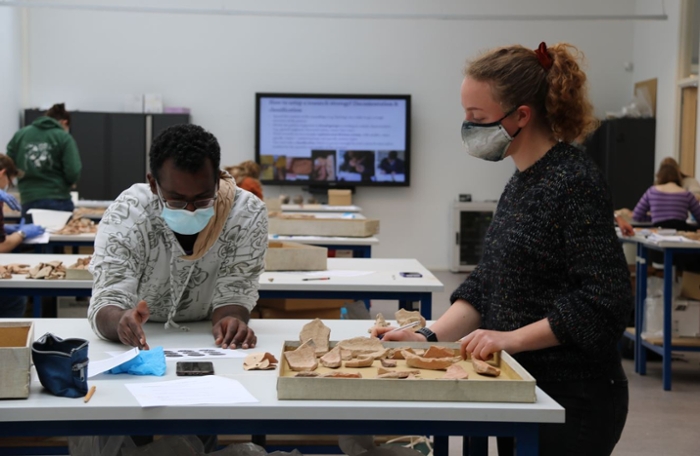
From excavation to public outreach: our bachelor's students experienced the full cycle of archaeology
In May and June of 2021, Bachelor 1 and 2 students of the Faculty of Archaeology joined in the excavation at Oss. After the fieldwork itself, a second post-excavations week started in Leiden where each of them participated in small groups conducting archaeological find processing and working on creative public outreach projects in archaeology. 'For our outreach project on our excavation on a bronze age site in Oss we decided to make a board game!'
Excavation and post-excavation
During the fieldschool weeks, the student were immersed not just in the excavation stage of archaeological work but in several subsequent parts of research beyond the dig itself. These experiences are crucial for students to see what happens after a site has been excavated and the finds stored. Archaeological projects as such entail a complex research process in which obtaining and interpreting data as well as communicating and sharing knowledge are all essential.

This first part of the post-fieldwork week consisted of a material practical during which the students got acquainted with especially ceramic materials. Organised in small corona-proof groups, students could see and touch pottery assemblages in the ‘Schervenzaal’ of the Van Steenis-building. The practical did include not only material pottery found at Oss in earlier years but also ceramics from other parts of the world were shown such as assemblages from the Near East and Central America.
Students learned how to look at these finds in a meaningful archaeological way: How to make sense of an apparently random pile of broken pieces of pot from past excavations? How to sort and classify these artefacts? How to provide detailed and systemic documentation and data usable for future research? These were the primary goals of this exercise.
To achieve this, students collaborated, shared insights and research strategies and discussed findings and interpretations with their fellow students and the teachers. This hands-on exercise proved a valuable addition to the excavation experience and introduced students to finds processing which is integrally connected to archaeological projects.
Public outreach
'The second post-fieldwork past consisted of reaching the general public and especially local residence of the area of Oss and the Netherlands more generally. Before starting on their assignment the students followed a workshop on outreach, again in small corona-proof groups of max. 15 students. In this workshop students were triggered to reflect on their positionality as an archaeologist in relation to communication with other persons, involving the broader public. Students discussed the way they were, or also were not, taught about their own history and how their own history was presented in their previous education, abroad but also in the Netherlands.
The assignment for the students was to create an outreach product, whilst taking into account their public and the aim, to learn that outreach is a practice of storytelling and intertwined with fieldwork and the different stages of doing archaeology. The products of the students varied from poster presentations, a concept for organizing an Open Day, websites to games and t-shirts! The best products are currently on display at the town hall of the municipality Oss, and will also be displayed at our faculty in a later stage.
Oss excavation: the board game
So how did the students experience the outreach projects? Asja Beumers group worked on an actual board game. 'For our outreach project on our excavation on a Bronze age site in Oss we decided to make a board game! We thought this would be a fun and engaging way to inform people about archaeology, using Oss as an example.'
The gist of the game is as follows: a board with flippable tiles shows a view of an excavation site from above. 'In the middle is a larger square representing the campsite and starting point of the game. The small tiles have either an artefact, feature, or plain dirt - all worth different scores- and the goal is to flip as many over and get as many points as possible before the burial mound tile is found which marks the end of the game.'
It sounds like fun, and, according to the students, it certainly was. 'We became so immersed in making the game work and being creative that this project didn’t feel like work to us anymore. We had a lot of fun while making it and were very satisfied with the result. We learned that there are many ways of conveying a message about an archaeological excavation. There was a lot of creativity in all groups, some made posters, others podcasts, some made games. Of course this is in addition to the amount of experience and insight we received while working on site for a week.'

8 hands in a video
The group of Daily Put worked on a video that would explain archaeology to children. 'My group and I made a video in which we explain in language for children what we did during the excavation. We also made cardboard cutouts that visualised the things we did. It was recorded in one take with 8 hands and about 15 moving pieces.'
Establishing the contents of the video turned out to be challenging. 'We learned how difficult it is to explain archaeology and its terminology to the general public.'

